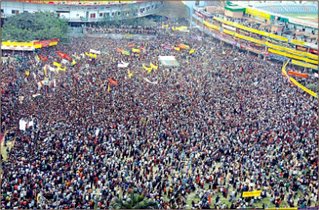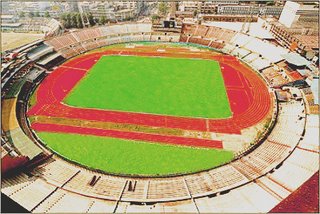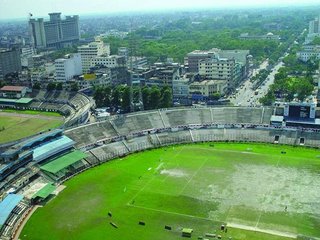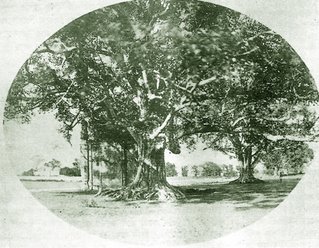
Paltan Maidan remaining space - best used by the politicians

Renovated Dhaka (BangaBandhu) Stadium

Dhaka (Bangabandhu) Football Stadium

Bhasani Hockey Stadium on left

Sher-e-Bangla Cricket Stadium, Mirpur

'Paltan Maidan' of 1900 with the big Banyan tree
Paltan Maidan: During British era 'Paltan Maidan' was a huge empty space lying between the Nawabpur old rail crossing and Purana Paltan. It was a kind of no-man's land, dividing the two 'Dacca's (now Dhaka) - old and new. Part of the ground was cleared for playing football (soccer), with the rest luxuriating in vegetation. In the 40s, the football field had a small wooden pavilion and gallery on the western side of field. The parameter was walled by CI sheet and ‘bullah’ posts.
Football (soccer) was and is the most popular game of Bangladesh. There were quite a number of premier football clubs in the 40s in Dhaka, most prominent were Wonderers, Victoria, Wari, Mohammedan sporting, EP Gymkhana, Railways, and Fire Service. Beside the 'League match' a tournament of 'Ronaldsay shield' was played. Alauddin, Nuru-Goda, Miaji, Madan, Shamsu, Kalipada, Macwa, Upendra and Saheb Ali were the popular local players. Noted clubs from West Bengal and elsewhere played in the tournament. A match between East Pakistan Governors XI vs. West Bengal XI was played in Dhaka in the late forties after which came the East Bengal and Mohan Bagan club from Kolkata with players like Mewalal, Nayer, Abid, Satter, Rashid, Latif and Ilyas to take part in friendly matches. Increased activities of football and sports demanded better playing condition, the field soil was improved and wooden gallery built on the eastern side to accomadate spectators. In early 50's, introduction of 'Makrani' and players from Karachi, such as, Abid Hasan, Yakub, Ibrahim, Abdullah, Musa, Kala Gafur, Torab Ali and Gafur Baluch brought in a qualitative change with acrobatic skill and style of play. 'Aga Khan gold cup' was introduced prabably in 54-55 that eclipsed 'Ronaldsay shield'. Dhaka became centre of regional Quadrangular football and RCD tournament.
Cricket. There was hardly any cricket field in Dhaka before partition. Cricket was played in the race course field under the patronage of Dhaka Club and some wealthy persons. In 1952, the Pakistan National Cricket team arrived Dhaka completing the first ever test series with India which they lost. Yet, the name of Kardar, Nazar Mohammad, Hanif, Fazal and Imtiaz came in limelight. They played a one-day exhibition match with Dhaka XI. The players stayed at the 'Ramna Rest House', a two storied building within a walled compound (west of 'Gulistan' building) owned by the District Board for temporary stay of important personalities and officials. Pakistan National team was captained by Abdul Hafeez Kardar. Hanif Mohammad earned the title “little master” in his teens from famous Indian cricket player, critic and commentator ‘Vizzy’- Moharaja of Vizianagram, India. The match was played in the DSA football field. Hanif and Nazar Mohammad opened the innings for Pak national team against Dhaka team. Hanif was out for a duck at the hand of ATM Mostafa (later central minister) at first slip. People wanted Hanif to stay on and continue play because many came to see him playing. Many in those days didn't know cricket rules.
When Pakistan cricket team won a test match in England at The Oval in 1954, the euphoria caused here many to take interest in cricket. The old timber stadium was demolished and replaced by a modern concrete structure with shopping facilities below. The west (main) gallery was completed in 1955. The shape of the cricket ground was made oval to commemorate the victory in the eponymous field in England. Though cricket was not played by many, it suddenly became a popular one amongst the youth in Dhaka. The new stadium was inaugurated with a test series between Pakistan and India.
The Dhaka stadium was completed in phases with a seating capacity upto 36000 spectators. All types of games- football (soccer), cricket, hockey, athletics played here. It also became the venue of receptions, cultural function and rallies. After independence of Bangladesh (1971), it was renamed ‘Bangabandhu Stadium’. On its south a new stadium (Bhasani stadium) was constructed for hockey and another (Sher-e-Bangla) stadium for cricket in Mirpur.
The wooden pavilion (of British era) of old stadium remained in its old location as the office of the Referees Association near Salimabad' restaurant opposite to the daily Morning News for a long period.
Also see, Dhaka BangaBandhu Stadium: Oldham Athletic Football of England lost to Dhaka Local Club;

1 comment:
I couldn't refrain from commenting. Very well written!
Take a look at my blog :: online stopwatch
Post a Comment